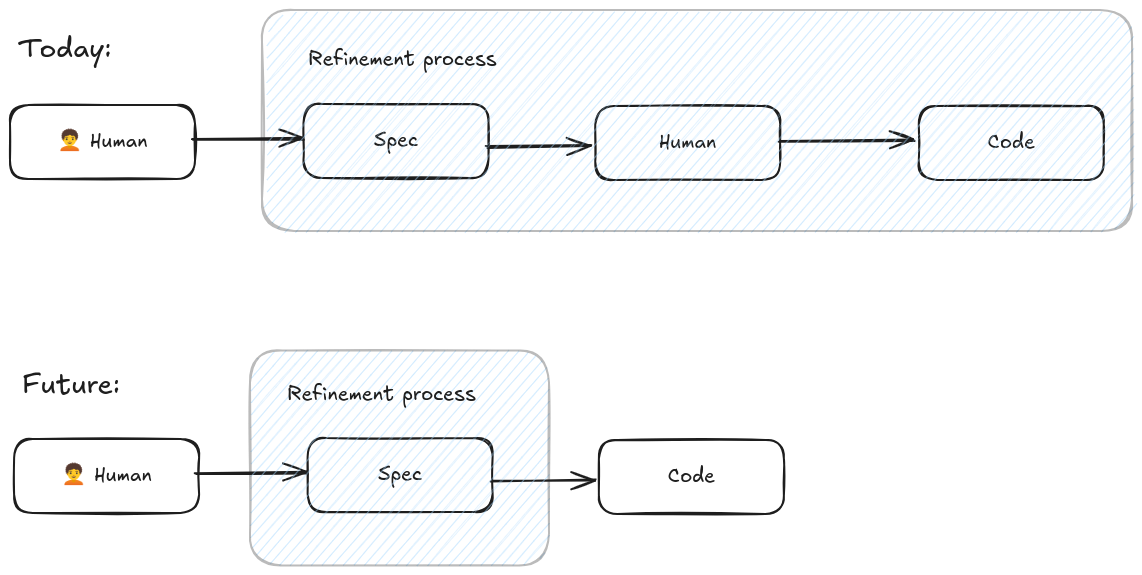Immutable codebase
· 4 minutes readOver the years, software development has evolved from writing raw code manually to leveraging tools and techniques that allow us to refine and optimize our codebase efficiently. The rise of tools like GitHub Copilot, Replit, and Cursor shows a shift towards a future where the role of developers changes drastically. These tools assist by refining the current state of the code, suggesting improvements, fixing bugs, and automating repetitive tasks. However, I believe this approach is just a step toward something much bigger—the immutable codebase.
The current trend: Refining the Code
Today, the process of writing code is no longer about typing every single line from scratch. Tools like Copilot analyze your patterns and suggest code based on your history, context, and known patterns. Also, in this space, we can find other complete development environments like Replit or Cursor having the all these new AI capabilities fully integrated. These tools make coding more efficient, but they’re still working with the idea of “refining” the current state of the source code.
As much as these tools help, they are still reactive. They improve code, but they do not fundamentally change the way we generate it. This is where I see the midterm evolution: a shift to a world where code is fully generated, not written or edited manually, and becomes immutable by nature.
Immutable codebase vision
Drawing inspiration from the concept of Immutable Infrastructure, that appeared years ago where infrastructure components were replaced instead of being modified, we envision that the same principles can apply to code. In immutable infrastructure, the idea is to avoid drift by replacing servers, containers, or resources instead of patching or tweaking them. Everything is built fresh and deployed clean. This reduces complexity, avoids configuration drift, and makes systems more predictable and stable.
Translating this concept to the realm of software development, imagine a system where codebases are generated in a fully automated, immutable fashion. Instead of incrementally changing code, developers would provide requirements, specifications, and constraints, and a system would generate the entire codebase. Any “change” wouldn’t involve editing the existing code. Instead, you would replace the entire codebase with a new one, regenerated from scratch based on updated requirements and configurations.
You could even imagine partial generation of the application for really complex application, where some specific modules are regenerated independently, allowing for a more modular and flexible approach while still maintaining immutability across the system. This way, individual parts of the system could evolve without risking inconsistencies or introducing legacy code issues.
As this evolution continues, future generations will marvel at how much effort we put into writing code by hand, asking in amazement: Did you code applications manually, really?
Looking ahead
While we’re still in the refining stage, I believe the midterm future of coding will rely heavily on generating code from a single source of truth—a comprehensive list of requirements and specifications. This approach not only simplifies the development process but also provides a more pure way of iterating application requirements, ensuring that all changes stem from well-defined inputs rather than manual adjustments. Developers will spend more time designing systems at a high level, allowing AI to handle the intricacies of code generation.
It will be the natural evolution of development, where humans bring more value by focusing on creative problem-solving, system architecture, and strategic decision-making, rather than the low-level mechanics of writing and maintaining code. By shifting the focus from manual coding to high-level design, we unlock more innovation and allow developers to work on tasks that require uniquely human insight.

However, the challenge now is realizing the sheer amount of non-written requirements an application has—implicit behaviors, unwritten assumptions, and domain-specific knowledge that currently live in developers’ heads. Capturing and formalizing these invisible aspects will be key to enabling true, automated code generation in the future.
Implications for product teams
This shift toward immutable, requirement-driven code generation will significantly impact product teams. This new single source of truth and the with this new automated code generation, product teams will be focused on defining precise requirements and iterating on user needs without worrying about the complexities of implementation. Updates and new features will flow more seamlessly from product vision to reality, as changes to requirements can directly influence code generation.
You can find similitudes of this stage when we jumped from manual assembly coding to high-level programming languages. The same way we abstracted the hardware details to focus on the logic, we will abstract the code details to focus on the requirements. This will allow product teams to move faster, iterate more efficiently, and deliver higher-quality software with fewer bugs and inconsistencies.
Conclusion
The shift toward an immutable codebase is inevitable as development tools become smarter and more sophisticated. Much like immutable infrastructure revolutionized IT operations, this concept will change how we think about software engineering. We start seeing this movement with tools like Bolt or Tessl, but we are still far from the full potential of this vision.
We are moving towards a future where the code will be the result of our vision, fully regenerated and perfectly tailored to fit. It will no longer need to be manually edited, patched, avoiding thousands of hours of maintaince.
Happy writing!